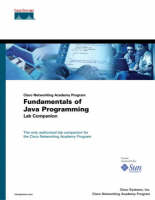
Fundamentals of Java Programming Lab Companion (Cisco Networking Academy Program)
Cisco Press (Verlag)
978-1-58713-090-8 (ISBN)
- Titel ist leider vergriffen;
keine Neuauflage - Artikel merken
The only authorized lab companion for the Cisco Networking Academy Program's Fundamentals of Java Programming online course.
Maps to the Web-based Java programming course sponsored by Sun Microsystems, Inc.
Provides students with an introduction to Java programming from a universally recognized leader in IT education.
Helps prepare students for the Sun Certified Programmer for Java 2 Platform exam.
Approved and recommended by Cisco Systems, Inc. for the Cisco Networking Academy.
The Fundamentals of Java Programming Lab Companion, along with the Fundamentals of Java Programming Companion Guide, complements the Fundamentals of Java course through the Networking Academy. This lab manual supplements the Companion Guide and offer labs to reinforce and support what the student has learned. It will allow the student the opportunity to perform all the lab tasks related to the Java Programming Web-based course, including the individual course project. The overall approach will be to provide students with a conceptual understanding of Object-Oriented programming, and to teach them how to use this technology to solve business problems through the use of hands-on labs. Students will learn how to create classes, objects, and applications using the language.
This book also includes labs that will cover the language fundamentals and the Java language API (application programming interface). Upon completion of the course and through the use of this lab manual, students will understand the Java environment and the use of the Java Development Kit, Java language keywords and syntax. They will be able to create statements, implement Javadoc feature in their souce files, understand code writing that implements 00 principles and design pattern, and write code to invoke and define. This title will help prepare the student for the Sun Certified Programmer for Java 2 Platform exam.
The Cisco Systems Worldwide Education curriculum development team in Phoenix is the developer of the Cisco Networking Academy Program's online curriculum, and is the co-developer of this book, with Aries Technology, Inc. Aries Technology is a multimedia curriculum development company located in Tempe, Arizona who has been working with WWE in developing the online curriculum. Aries education products and information can be viewed at www.aries.net.
1. What Is Java?
Locating Resources, Managing Editors, and Console Windows. Creating and Running the HelloStudent1 Class. Modifying the HelloStudent1 Program to Accept Input from User at Runtime. Debugging and Correcting Errors in Predefined Classes. Creating HelloStudent3 with BlueJ. Exploring the BlueJ Tutorial. Create and Run the Teller Class. Case Study: Modify the Teller Class to Accept Runtime Data.
2. Object-Oriented Programming.
Teacher Class Calls Student Class. Designing and Describing Classes by Using UML. Developing the Banking Classes for Phase 1.
3. Java Language Elements.
Exploring Javadoc Parameters. Reviewing the API Documentation. Inserting Documentation for the Classes in the JBANK Application. Generating API Docs for JBANK Classes Using Javadoc Tool. Defining Variables. Applying Access Modifiers. Using Constructors. Creating the Classes for Phase I of the JBANK Application.
4. Java Language Operators and Control Structures.
Arithmetic Operators. Use of Operators. String Concatenation. If Statement. Switch Statements. Do While Statement. Use of While Loops. For Loops. The java.lang System Class. The Console Class. Control Structures.
5. Basics of Defining and Using Classes.
Four Steps to Creating Objects. Creating Objects, Encapsulation Concepts, and Attributes. Constructors and Methods. Overloaded Methods and Constructors. Scope of Variables. Completing the JBANK Phase 1 Application.
6. System, Strings, String Buffer, Math and Wrapper Classes.
Reading Input Using System.in String Methods. Casting and Conversion. Using the Math Class. Using the Math Package. Working with Dates. System, String, StringBuffer, and Use of the Console Class. Wrapper Classes, Math Class, Date Class.
7. Arrays.
Passing an Array to a Method. Creating and Traversing Through Arrays. Searching and Sorting an Array. Extended Use of Arrays.
8. Classes and Inheritance.
Implement Abstraction in the Banking Application. Implement Inheritance, Extending from Abstract and Concrete Classes. Abstraction at Several Levels-Create Checking Account. Interface and Abstract Class. Polymorphism in the Banking Application.
9. Understanding Packages.
Exploring the API Packages. Build a Banking Package. Designing the GUI to Represent an ATM for Customers. Designing the GUI Interfaces.
10. Creating GUIs Using AWT.
Creating the Components (TellerView Class). Creating the Components (ATMGUI Class). Selecting Containers (TellerGUI Class). Selecting Containers (ATMGUI Class). Layout Managers (TellerGUI Class). Layout Managers and Adding Components. (ATMGUI Class). Identifying Event Handler Features in the TellerGUI Class. Implement Event Handling for the ATMGUI Class. Implement the Model for the ATMGUI Class. Finalizing the Model View Controller Pattern for the ATMGUI Class.
11. Applets and Graphics.
Creating an Applet to Display Employee Information. Graphical User Interface (GUI) Components in Applets. Changing the Location of Components in an Applet. Calculator. Creating an ATM Applet.
12. Exceptions.
Testing for Run time Exceptions. Using the Finally Block. Creating Your Own Exceptions. Exceptions for the JBANK Application.
13. Files, Streams, Input and Output.
Displaying File Statistics. Using RandomAccessFile to Seek Positions Within a File. Writing Customer Objects to a File. Reading Customer Objects from a File.
14. Collections.
ArrayList. ListIterators. Creating a collection to Store Integer Objects. File I/O Using Collection Classes. Set and Iterators.
15. Threads.
Threads and Priorities. Controlling Threads by Using Methods of the Thread Class. Digital Clock.
| Erscheint lt. Verlag | 16.4.2003 |
|---|---|
| Verlagsort | Indianapolis |
| Sprache | englisch |
| Maße | 218 x 277 mm |
| Gewicht | 671 g |
| Themenwelt | Informatik ► Programmiersprachen / -werkzeuge ► Java |
| Mathematik / Informatik ► Informatik ► Web / Internet | |
| ISBN-10 | 1-58713-090-4 / 1587130904 |
| ISBN-13 | 978-1-58713-090-8 / 9781587130908 |
| Zustand | Neuware |
| Haben Sie eine Frage zum Produkt? |
aus dem Bereich


